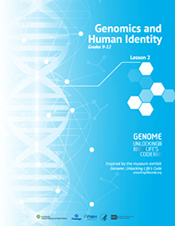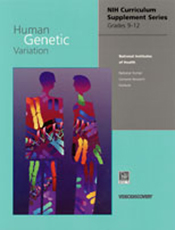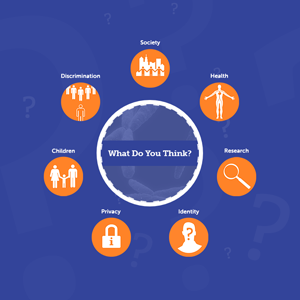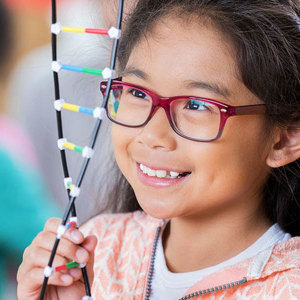Human Identity & Genetic Variation

What Is It?
Genomics and Human Identity is an exciting teaching resource for grades 6-12 inspired by the museum exhibit Genome: Unlocking Life’s Code, and developed with support from the Promega Corporation. This free classroom resource includes an informative and clearly written teacher’s manual, engaging student handouts, and supplementary PowerPoint slides.
The two activities in this lesson encourage students to observe and draw conclusions about the structure and function of the human genome – whether demonstrated by the curl of person’s tongue, the shape of their ear lobes, or in the invisible sequences of their DNA.
How Does It Work?
The first interactive activity focuses on the occurrence of four visible human traits. Students will launch their own inquiries: surveying their classmates, identifying which group they belong to, and discussing how they resemble or differ from others in their trait-defined group.
In a second activity, students work together to identify small differences in long DNA sequences from two individuals. This exercise leads naturally to discussing variations in DNA – insertions, deletions, single nucleotide changes – that underlie human differences, as well as the high similarity of DNA in close relatives and even among all humans (99.5% identical).
Why Is It Important To Me?
Starting with the survey of real people, whose photos bring the results alive, students learn to identify these traits in themselves and others and to see how “different” people may belong to the same group defined by these four traits.
Pairing an activity on visible traits with one on DNA variation helps students grasp the link between human diversity and DNA sequences. Both activities share the theme that the differences are surprisingly small – and, whatever their surface appearance, people are far more alike than different. This lesson can stimulate discussions ranging from physical traits, to genetics, to human identity, and far beyond!
Curriculum
Human Genetic Variation
From the National Human Genome Research Institute, this free curriculum supplement is designed for use in high school science classes. It provides online activity links and resources for teaching the basics of human genetics, its potential to improve human health, and its application toward understanding and describing human evolution.
Human Identity Lesson Plans
Bring genomics to life for your high school students with the "Human Identity Lesson Plan" series. Inspired by the Genome: Unlocking Life's Code exhibition, these lessons encourage hands-on, inquiry-based learning and include genomic concepts and research projects.
Human Identity Lesson Plan 1:
The two activities in this lesson encourage students to observe and draw conclusions about the structure and function of the human genome – whether demonstrated by the curl of person’s tongue, the shape of their ear lobes, or in the invisible sequences of their DNA.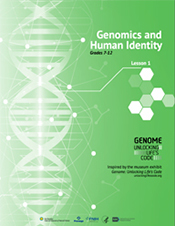
Human Identity Lesson Plan 2:
In 2010, fishermen in the Bahamas caught a tiger shark containing human remains: But whose remains were they? Step-by-step questions guide students through the logical progression from analyzing forensic data to identifying the remains.
